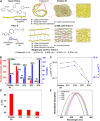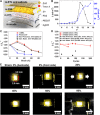Intrinsically stretchable organic light-emitting diodes
- PMID: 33627424
- PMCID: PMC7904263
- DOI: 10.1126/sciadv.abd9715
Intrinsically stretchable organic light-emitting diodes
Abstract
Soft and conformable optoelectronic devices for wearable and implantable electronics require mechanical stretchability. However, very few researches have been done for intrinsically stretchable light-emitting diodes. Here, we present an intrinsically stretchable organic light-emitting diode, whose constituent materials are all highly stretchable. The resulting intrinsically stretchable organic light-emitting diode can emit light when exposed to strains as large as 80%. The turn-on voltage is as low as 8 V, and the maximum luminance, which is a summation of the luminance values from both the anode and cathode sides, is 4400 cd m-2 It can also survive repeated stretching cycles up to 200 times, and small stretching to 50% is shown to substantially enhance its light-emitting efficiency.
Copyright © 2021 The Authors, some rights reserved; exclusive licensee American Association for the Advancement of Science. No claim to original U.S. Government Works. Distributed under a Creative Commons Attribution NonCommercial License 4.0 (CC BY-NC).
Figures




References
-
- Liang J. J., Li L., Niu X. F., Yu Z. B., Pei Q. B., Elastomeric polymer light-emitting devices and displays. Nat. Photonics 7, 817–824 (2013).
-
- Kim D.-H., Lu N., Ma R., Kim Y.-S., Kim R.-H., Wang S., Wu J., Won S. M., Tao H., Islam A., Yu K. J., Kim T.-i., Chowdhury R., Ying M., Xu L., Li M., Chung H.-J., Keum H., McCormick M., Liu P., Zhang Y.-W., Omenetto F. G., Huang Y., Coleman T., Rogers J. A., Epidermal electronics. Science 333, 838–843 (2011). - PubMed
-
- Larson C., Peele B., Li S., Robinson S., Totaro M., Beccai L., Mazzolai B., Shepherd R., Highly stretchable electroluminescent skin for optical signaling and tactile sensing. Science 351, 1071–1074 (2016). - PubMed
-
- Sekitani T., Nakajima H., Maeda H., Fukushima T., Aida T., Hata K., Someya T., Stretchable active-matrix organic light-emitting diode display using printable elastic conductors. Nat. Mater. 8, 494–499 (2009). - PubMed
LinkOut - more resources
Full Text Sources
Other Literature Sources

